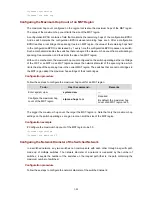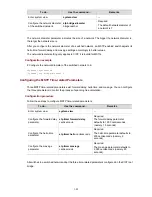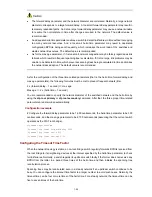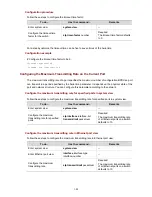
1-21
To do...
Use the command...
Remarks
Enter system view
system-view
—
Enter Ethernet port view
interface interface-type
interface-number
—
Configure how a port
recognizes and sends
MSTP packets
stp compliance
{
auto
|
dot1s
|
legacy
}
Required
By default, a port recognizes and sends
MSTP packets in the automatic mode.
That is, it determines the format of
packets to be sent according to the
format of the packets received.
Configuration example
# Configure Ethernet 1/0/1 to recognize and send packets in dot1s format.
<Sysname> system-view
[Sysname] interface Ethernet 1/0/1
[Sysname-Ethernet1/0/1] stp compliance dot1s
# Restore the default mode for Ethernet 1/0/1 to recognize/send MSTP packets.
[Sysname-Ethernet1/0/1] undo stp compliance
Configuring the MSTP Operation Mode
To make an MSTP-enabled switch compatible with STP/RSTP, MSTP provides the following three
operation modes:
z
STP-compatible mode, where the ports of a switch send STP BPDUs to neighboring devices. If
STP-enabled switches exist in a switched network, you can use the
stp mode stp
command to
configure an MSTP-enabled switch to operate in STP-compatible mode.
z
RSTP-compatible mode, where the ports of a switch send RSTP BPDUs to neighboring devices. If
RSTP-enabled switches exist in a switched network, you can use the
stp mode rstp
command to
configure an MSTP-enabled switch to operate in RSTP-compatible mode.
z
MSTP mode, where the ports of a switch send MSTP BPDUs or STP BPDUs (if the switch is
connected to STP-enabled switches) to neighboring devices. In this case, the switch is
MSTP-capable.
Configuration procedure
Follow these steps to configure the MSTP operation mode:
To do...
Use the command...
Remarks
Enter system view
system-view
—
Configure the MSTP operation
mode
stp mode
{
stp
|
rstp
|
mstp
}
Required
An MSTP-enabled switch
operates in the MSTP mode by
default.
Configuration example
# Specify the MSTP operation mode as STP-compatible.
















































